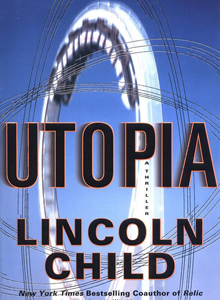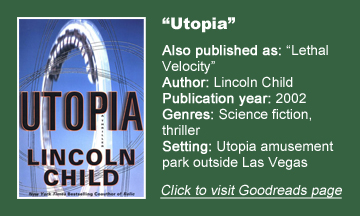After six novels co-written with Douglas Preston, Lincoln Child goes solo for “Utopia” (2002), which I remembered as setting a high bar for all his future works (a bar he sometimes passes). Set in a cutting-edge theme park, it’s thematically on par with Michael Crichton’s movie “Westworld” (robots who can learn) and book “Jurassic Park” (the unforeseen problems of newly implemented technology).
Ambitious world building
On this second read, I found “Utopia” – for some reason retitled “Lethal Velocity” in later printings — to be not quite a masterpiece, but still an engaging read, and certainly ambitious, especially in its world building.
Today, I suppose a close comparison might be Orlando’s Wizarding World of Harry Potter, and I also imagine the Mall of America’s Camp Snoopy – in the sense that it’s indoors — multiplied a hundredfold. Maybe this book was slightly more eye-opening in 2002.
But even so, there’s nothing in today’s world on the scale of Utopia. Under a huge dome constructed amid desert mesas a half-hour drive from Las Vegas, it’s four theme parks in one, attracting daily attendance on par with a major-college football game.
A new small town of employees has cropped up nearby, and obsessive fans (Utopians) chat about the year-old park on the web.
Child’s imagination is infectious as he describes Camelot, Gaslight, Boardwalk and Callisto; plus, the waterworld Atlantis is under construction. Utopia is largely run by artificial intelligence, and it uses things that aren’t quite here (at least at consumer grade), such as holograms and artificial gravity.
Regular-guy hero, mundane villains
“Utopia” is arguably over-imagined, because the villains’ plot seems mundane in comparison to the setting. In the style of “24” – in that the action takes place from open to close at the park – the story stalls at times, with our heroes even wondering why the villains are still around after an initial objective has been achieved.
Dr. Andrew Warne, who designed Utopia’s now-malfunctioning self-learning AI, is an Everyman combined with touches of extreme heroism wherein we hope we’d act like he does. I couldn’t shake the feeling that his 14-year-old daughter, Georgia, is along for the sake of being put in peril, and indeed, Child could’ve done more with her.
Warne’s budding romance with fellow computer engineer Terri – an Asian woman, as will be common in Child books — is cute, as is the way Georgia approves or disapproves of women in his widower father’s life.
The villains, who use code names — “Prime Factor” is the leader, but he tells park head Sarah Boatwright, an ex of Warne’s, to call him “John Doe” — are scary enough that their scheme is compelling through about 75 percent of the narrative. Then the conclusion becomes rote as the action outstrips the intrigue.
A legit solo novelist
Although it’s fair to broadly compare “Utopia” to “Jurassic Park,” Crichton’s work is research-oriented in a way that provides a sense of immediacy because he showcases real research and real history within the book. Child believably creates Utopia, but doesn’t quite achieve the “wow” factor of what artificial learning can lead to.

He anthropomorphizes two robots – the doglike Wingnut and the ice-cream vendor Hard Place – but the big reveals about what they can do beyond Warne’s programming don’t come until the very end. We don’t get the chilling sea-change mystery that Crichton provides when on his game, or that TV’s “Westworld” delivers when at its best.
Ultimately, Utopia the park is epic in scope, but “Utopia” the novel is less epic in its story or insightful statements about technology. But Child’s wondrous descriptions of the park are nothing to sneeze at. We can’t yet visit rides or attractions quite so high-tech, but Child gives us the next-best thing by prompting our imaginations.
I wouldn’t be surprised if “Utopia” took him longer to write than any of his later novels, but all that work accomplishes one clear thing: He’s a legitimate solo novelist.


